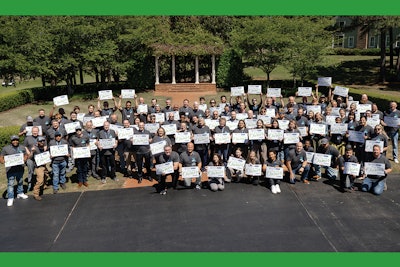
When you read pool and spa trade publications, including AQUA, or attend conference seminars, succession is a hot topic. “‘Do you have a solid succession plan in place?’ is what I always hear,” says Rene Huston, president of Patio Pleasures in Sun Prairie, Wis.
But for Patio Pleasures, the subject of succession has been a puzzling one. “In our business, there are four of us, which provides a level of complexity — you have four different visions of what a succession plan may look like,” says Huston. Patio Pleasures is also family owned and while some of their kids have worked a little for the company, others have not, so Huston and partners Tom Tritt, Adrianne Morgan and Brett Huston did not have a lot of confidence in the second generation taking over.
Then, the team started to look at an Employee Stock Ownership Plan (ESOP), and they liked what they saw. With the help of ESOP Partners — a company that guides business owners all throughout the United States as they launch successful ESOP plans — Patio Pleasures officially announced its transition to an ESOP, effective June 1, 2024.
Georgia Spa Company of Auburn, Ga., recently celebrated the same milestone.
When Josh Kemerling, CEO, observed friends in the pool and spa industry selling to large corporations, he feared Mark Stevens, founder, would do the same. “I have been with Mark since day one in 2004,” Kemerling says. “He had mentioned giving me the first right of refusal to purchase the business, but as Georgia Spa Company grew, especially during the pandemic, I realized I was not going to be able to afford this. We’ve grown this out of reach for me.”
That’s when Kemerling sent Stevens an email where he proposed three options: (1) Kemerling and others form a group to purchase the company, (2) Stevens semi-retires and Kemerling, along with an executive team, takes over the business, or (3) they consider an Employee Stock Ownership Plan.
Stevens initially expressed doubts about the ESOP process; however, after attending a conference hosted by the National Center for Employee Ownership (NCEO) titled “Is an ESOP right for you?” and getting some guidance, he became convinced the ESOP route was the right one.
The company proceeded and on May 2, 2023, during a company-wide meeting, Stevens surprised employees by revealing he had sold the business to them through an ESOP.
Throughout the extensive process, both Patio Pleasures and Georgia Spa Company learned a lot. “It’s a whole different language,” says Stevens. “It was initially way over my head, and that was a hurdle to overcome — the complexity of it all.”
“Two years ago, if you had asked me about an ESOP, I would have looked at you and said, ‘I don’t know what that is. Tell me more,’” adds Huston.
It’s true that as pool and spa companies consider if an ESOP is right for them, the process can be overwhelming, and it’s hard knowing where to start. As such, we spoke with Matt Middendorp — a consultant at ESOP Partners who helped guide Patio Pleasures every step of the way — to gain a basic understanding of an ESOP and how a company can come to realize if it’s right for them.
 Mark Stevens makes the announcement that Georgia Spa Company has transitioned to an ESOP.
Mark Stevens makes the announcement that Georgia Spa Company has transitioned to an ESOP.
IS AN ESOP RIGHT FOR YOU?
The first thing to establish when deciding if an ESOP is right for you, is to determine if you are in the right place to even be considering one, says Middendorp.
“I tell companies they are in the right place for an ESOP if (1) they are starting to think about what’s next for their successful business, and the name on the door means something to them; (2) the company’s accountant, attorney or banker suggested an ESOP might be worth considering; (3) you’ve built a successful business and want to reward your employees who have helped you get there; or (4) you’re competing against an ESOP company for customers and for new hires, and they are beating you at both. After you have determined if you check one or more of these boxes is when you should look into it.”
For Patio Pleasures and for Georgia Spa Company, it was really No. 3 that was the motivating factor. “Our team is such a big part of our success and a big part of our family,” says Huston. “We thought, what a cool opportunity to set them up for great retirement success and wealth.”
“A lot of these companies that I work with, where an ESOP is right for them, want to keep jobs in their local community,” adds Middendorp. “They want to give back to their employees. A lot of them have their names on the football field or high school basketball arena — they’re ingrained, and they want that to continue. That really doesn’t happen in most circumstances when a business is sold.”
WHAT DOES A SUCCESSFUL ESOP COMPANY LOOK LIKE PRE-ESOP?
(courtesy of Middendorp)
- Strong balance sheet and cash flow
- Enough taxable income to make tax savings worth it
- Minimum of 15 to 20 employees (guideline, not a rule)
- Able to convert to an S-CORP or C-CORP
- Effective communication between management and employees
- Has a succession plan in place or intends to put one in place before the owner transitions out
WHAT IS AN ESOP?
There are several people involved in an ESOP transaction: the seller, the company (aka, your baby) and the ESOP trust. “How this works is, the seller is selling the company to an ESOP trust,” says Middendorp. “The ESOP trust is overseen by the trustee, who is usually someone the seller hires.”
An ESOP can be viewed three ways…
As a business transition tool — An ESOP is not necessarily an exit strategy, as not every business owner who sells their company is looking to get out. In fact, most of them stay for years and years. “For some owners,” explains Middendorp, “an ESOP is a strategic plan that allows their business to evolve and meet their goals.”
For instance, when Patio Pleasures celebrated its 20th anniversary this year, the company was asking what’s next. “We’ve got so much more we want to accomplish yet in this industry,” says Huston. “For us, we still have a very strong commitment for at least five years to make sure the company continues to grow.”
An ESOP will help to contribute to the company’s growth. According to the NCEO, companies grow 2.3% faster post-plan than they would have expected to pre-plan. ESOP companies also see a 4 to 5% improvement in productivity, on average, in the year the ESOP is adopted. And they grow on average 2.3 to 2.4% more per year.
Why? “Companies can attract better talent, and they improve employee retention,” says Middendorp. “ESOP companies are also 4X less likely to lay somebody off. It also helps that their retirement portfolio is typically two or three times more working under an ESOP.”
As an employee ownership vehicle — You can align the financial goals of the company with the financial goals of your employees. “Employees can consider, when they contribute to the success of the company, there is a direct benefit to them through the ESOP trust. That kind of alignment just doesn’t happen under any business plan,” says Middendorp.
Huston agrees. “The reality is that when you operate as an owner, you are 100% tied to the investment and to the liability and success of the company. You make decisions differently than you would if you were an ordinary employee who is not tied to that final outcome. As an ESOP, everyone shares in that owner mentality, and is more aware of how the success and profitability of the company can benefit everyone on a much greater scale.”
As a qualified retirement plan — An ESOP is provided at no cost to employees, and employees don’t have to put their own pre-taxed dollars into the retirement plan. “An ESOP is also the only qualified retirement plan that is allowed to borrow money,” says Middendorp.
An ESOP can also help older employees transition into retirement, specifically those who work in the pool and spa construction and service sectors. “These are people who have worked in the construction industry for a long period of time,” explains Middendorp, “and when they hit 50, 55 years old, their bodies just can’t keep doing it. They also may recognize they’re probably not saving enough. An ESOP can help them transition into retirement, and allow them to take the next steps in their life comfortably."
Another benefit: “The portion of an S-Corporation owned by an ESOP is generally not subject to state and federal income taxation. If you are an S-CORP, and you are 100% employee owned, you no longer pay state or federal income tax as a business, and that’s not a small thing,” says Middendorp. “It’s proportional. If you are 30% employee owned, you get 30% of that benefit. If you are 60% employee owned, you get 60%, on up to 100%. For any business owner, what would you do with that tax money for your business? It’s something to think about when you are thinking about your goals and accomplishments as a business owner.”
3 STAGES OF ESOP EXPLORATION
STAGE 1: I THINK I WANT TO ESOP.
Where does the thought process start? “You may have something going on in your business, and/or want to level-up your business, depending on what your motivations and goals are, you may have something you want to figure out,” says Middendorp.
Next, you hear about ESOP and, being curious, you may attend a session. You may connect with an ESOP professional and begin to gain clarity and confidence that this could be what you’re looking for, so you decide to formally create a decision-making tool known as a feasibility study. (ESOP Partners puts together this no-cost initial assessment which gathers information needed to make key decisions about corporate structure, the sales transaction and financing, plan design, regulatory compliance, ongoing administration and more.)
“I think this is where some people may get cold feet,” explains Stevens. “Before you consider the feasibility study, I recommend having three pieces in place. (1) Get educated, and hire a consultant. (2) Ask yourself, ‘Are you willing to let people come in and take an unbiased look at all your operations — and not get offended when they say you need to be doing something differently? (3) Do you have a management team in place where your business could run without you? If not, you may need a few years before you proceed.”
The feasibility study looks at all kinds of company data, says Huston. “They look at how many employees you have, how many hours they work, how much money they make, and you can’t have too many family members on payroll. It can’t be too top-heavy where four people make the most amount of payroll, and the rest makes a lot less.”
This decision-making tool then allows a company to ultimately say yes or no — let’s proceed or I’m not interested in moving forward.
STEP 2: I KNOW I WANT TO ESOP.
After a company determines an ESOP is right for them, it’s time to set one up. Three tracks happen all at once, says Middendorp.
“You hire your professional team — your trustee, the person you are negotiating with to sell the company. They represent the ESOP trust, who buys the company from the seller and negotiates the sales price. How often do you get to hire the person you are negotiating with for the sale of your company? It’s a pretty neat concept.
“Next, you hire an attorney who specializes in ESOPs, someone who aligns with your personality and goals, as they will be instrumental in ensuring the process goes smoothly. And finally, you create the ESOP itself, and decide how the ESOP trust is going to run.”
At this stage, Huston says, you determine some important specifics. “For example, we chose that employees must have a minimum of 1,000 hours a year to qualify for the ESOP, and they must be 21 years of age to qualify for our vesting schedule. We also went back and said that for our prior employees, who have been with us for at least six years, we are going to fast track their vesting schedule to show that longevity has its rewards; these people are automatically 100% vesting from day one. So there’s a lot of different things you can do, and these decisions were all made with the guidance of ESOP Partners.”
Negotiations are then executed to make sure the sellers get the return they were expecting. “Now, that may sound like a small thing,” says Middendorp, “but ESOP negotiations are very different from what you might have seen if you’ve ever sold a business or been part of a due diligence process, selling to private equity or selling to a third party. The goal of an ESOP negotiation is to find the fair market value of a company. Two groups of people come together to find the right price versus two groups of people coming together with very different goals, trying to best each other. With an ESOP negotiation, it happens more quickly and with much less angst.”
STAGE 3: WE ARE AN ESOP.
At this point, the ESOP is operational, and employees are getting onboard. Management should be able to understand and answer all questions employees may have. “It is important to create an employee ownership committee, who walks through a certification process, to oversee that ESOP culture and help to drive it forward — they are ambassadors with knowledge and can spread good information. The last thing you want is people running to Google searching ESOP and finding the wrong information.”
For Georgia Spa Company, this stage was the most fun, as it’s when they made the announcement. The company shut down all six of its retail stores, across all departments, and gathered offsite at a country club where they normally hold company celebration dinners. The executive team had worked hard on goodie bags and had purchased a large cake.
“When Mark started the meeting, he said, ‘There have been a lot of rumors recently that I sold the business,’” says Kemerling, as the rumor mill was flying leading up to the meeting. “He said, ‘At the end of the day, I have sold the business, and I’m here today to introduce you to the new owners.’”
He recalls that everyone was looking around, wondering who it could be. Stevens then asked employees to stand and said, “‘Look around, you now own this business.’ And you could hear a pin drop. Once employees realized it wasn’t a payroll reduction — that we were giving them the business — there was a lot of excitement.”
Kemerling looks back on that day and still gets goosebumps and is filled with emotion. “I look at 20 years of history, and that’s certainly a big day where the sun was shining on us, and we were smiling from ear to ear.”
FOR THE RIGHT STORY, A HAPPY ENDING
As great as it feels to reward the people who helped you climb the ladder, Middendorp says that, in the end, it’s about the potential tax benefits of selling to an ESOP that really sets your business up for long-term success. “But ESOP is not an option for every business owner,” he says. “Ultimately, it needs to line up with your goals and the goals of your business. You need to understand where your business is, and where you are trying to get to.”
“You also have to understand that, if you are looking for an immediate payout, and you’re ready to retire or step away sooner rather than later, that this may not be the right fit for you,” adds Huston.
That’s not to say it can’t be done, as Stevens was able to semi-retire; he now serves as chairman of the Board. “But that’s because Mark already worked very little on the business side, and for the past 10 years or so, only worked on the accounting side,” says Kemerling. “He hadn’t sold a hot tub in 15 years, and hadn’t delivered one in 19 years. We’re very fortunate he looked at the big picture of those he left behind.”
“I had friends who were pushing me to go the other direction,” says Stevens, “and I had the opportunity to sell a couple different ways — but this route, ESOP, was right for me. Not only to preserve the company culture, but because I had a longer exit runway. I was able to take advantage of an ESOP ending.”
He encourages people in their 40s to be thinking about how they’re going to exit the business in 10 or 15 years.
“Why not?” he says. “Don’t wait until you feel you have to sell the business just to sell the business. Put those pieces in place now, and get everything cleaned up, because ultimately, this is how we should have been running the business for the past 15 years. It’s so much more enjoyable. You’re not constantly putting out fires. You’re not constantly doing things that every business owner hates. You’re doing the stuff that you enjoy — and that’s growing a business, and it’s thriving, because everyone has a piece of the puzzle.”
For more information on employee stock ownership, contact Matt Middendorp at [email protected].












































